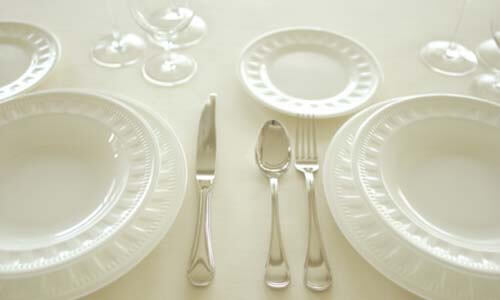Cups
Table Setting Guide
The cup is made in seven sizes, each with a different volume capacity:
- Breakfast cup;
- Mug;
- Teacup;
- Coffee cup;
- Chocolate cup;
- After-dinner coffee cup; and
- Demitasse cup.
Although the expression "cupful" denotes a half-pint serving, or 4 ounces, the size of the cup is determined by the strength of the drink, the time of day the drink is served, and whether it is thick or thin.
Large cups and mugs are made to serve thin, hot beverages during breakfast and lunch, such as coffee, tea, and cocoa, or cider on a cold afternoon.
Small cups are made to serve strong-tasting beverages, such as espresso; drinks with a thick consistency, such as hot chocolate made from paste; and potent drinks made with alcohol, such as grog.
Regardless of size, cups and mugs are filled approximately three-quarters full, except for the demitasse cup, which is filled half full.
Moreover, all cups except mugs are made with companion saucers. The dimensions of the following vessels are approximate.
Breakfast Cup and Saucer
As the popularity of drinking coffee increased in the nineteenth century, so did the need for cups with a higher volume capacity. The breakfast cup was born. The breakfast cup is approximately 3 ¼ inches in height by 4 ½ to 5 ¾ inches in diameter. The companion saucer measures 6 ¾ to 8 ¾ inches across.
Mugs
The mug is heavier than a cup, the walls are thicker and the base is denser. To retain heat, the mug is taller than a cup, made in regular and extra large sizes. Regular-size mugs are approximately 3 to 4 inches in height by 3 ½ inches across, a vessel with a volume capacity of around 8 to 10 fluid ounces when filled almost to the rim. Extra large mugs are the American counterpart of the European breakfast cup, a shape about 4 inches in diameter or more, a size that holds approximately 15 to 20 fluid ounces. To accommodate the shape of the mouth, the mug often flares outward at the rim.
The mug is used only for informal dining.
Teacups
Tea is a beverage cooled slightly before drinking, and to release heat, the teacup is slightly shorter and a little wider than the coffee cup, a shape approximately 3 ¼ to 3 ¾ inches in diameter by 2 to 2 ½ inches in height. The companion saucer measures about 5 ¼ to 5 5/8 inches across. To accommodate the shape of the mouth, the rim of the teacup is often flared outward, a form derived from the beaker (from the Latin beccus, for "bird's bill").
Although the teacup is used at informal meals, the flavor is too delicate to follow a heavy multi-course meal, and tea is not served at formal dinners and at formal luncheons only upon request.
Coffee Cup
Coffee is a beverage served from early morning to late evening, and the size of the cup is determined by the time of day it is taken, along with the strength of the brew. Coffee with a brisk taste, a light body, and a high caffeine content is served as a stimulant, notably at breakfast and lunch, in a large cup. Coffee with a strong taste, heavy body, and a low caffeine content is served as a digestive following a multicourse meal, such as after dinner, in a small cup.
Coffee is at its peak flavor when served extremely hot. To conserve the heat, the cup features a cylinder shape, taller than wide, a size approximately 2 ½ inches in height by 3 inches in diameter. The companion saucer measures around 6 to 6 ½ inches across.
The coffee cup is made in three sizes, namely, the regular-size coffee cup, the after-dinner coffee cup, and the demitasse cup. The regular-size coffee cup is used at informal meals, the after-dinner coffee cup at elegant informal affairs, and the demitasse cup at formal occasions.
After-dinner coffee is a strong-flavored brew with a low caffeine content served to stimulate digestion at an elegant multi-course meal. The smallish cup measures approximately 2 3/8 inches in height by 2 ½ inches in diameter and holds approximately 3 ounces. The companion saucer is about 4 ¾ to 5 inches across. Rather than interrupt good conversation and take coffee in another room, after-dinner coffee is often served at the dinner table.
Demitasse
Demitasse is a heavy-bodied brew with a strong taste and low caffeine content. It is served to aid digestion and dispel the lingering effects of alcohol after a formal dinner where several wines are served. Demitasse means "half cup" in French, and the cup is approximately 2 ¼ inches in height and width, slightly shorter and narrower than the after-dinner coffee cup. The companion saucer measures about 4 ½ to 5 inches across.
Guests at a formal dinner are seated at the table for hours, so in order to provide them with the opportunity to stretch and regroup, and to revive conversation, demitasse is presented in another room. The cup is filled half full (approximately 1.5 ounces). Customarily, at a formal affair, demitasse is followed by brandy or liqueur; entertainment-dancing or cards-may then commence. A second cup is not offered.
At an informal meal, demitasse is served away from the table, wherever is convenient.
Chocolate Cup
Originally hot chocolate was a breakfast drink made from unsweetened chocolate mixed with cream, a mix beaten into a thick paste. Just before serving, sugar and hot frothy milk were added. To accommodate demand, in the second half of the eighteenth century the morning chocolate cup was larger than a coffee cup or teacup. However, the thick paste was slow to pour, and at social affairs in the afternoon, hot chocolate was served in small narrow cups about 3 inches in height by 2 ½ inches in diameter. The companion saucer measured approximately 4 inches across.
Today, hot chocolate is made from powdered cocoa, a thinner beverage than the original drink; it is served in a large vessel, such as a coffee cup, teacup, or mug. Small chocolate cups purchased in specialty stores are not made as part of a dinnerware set.



